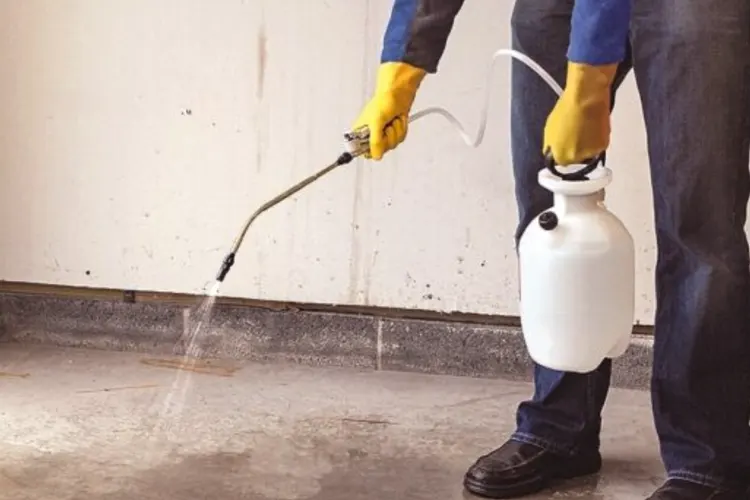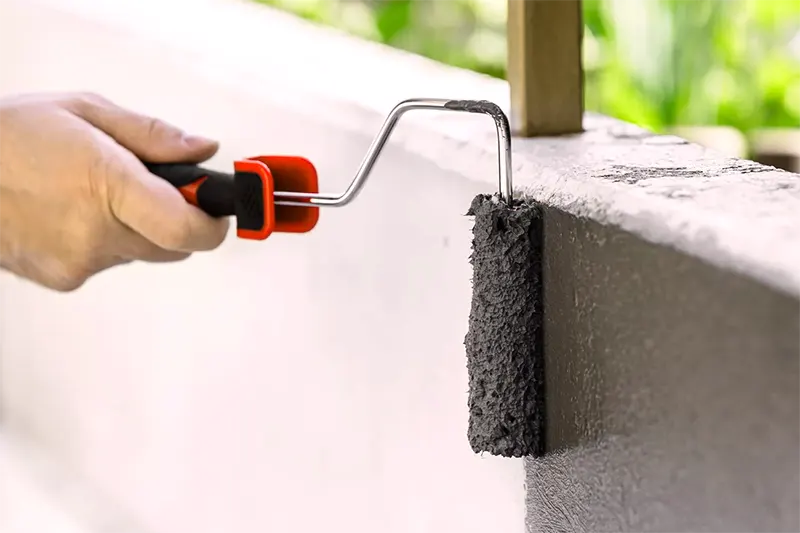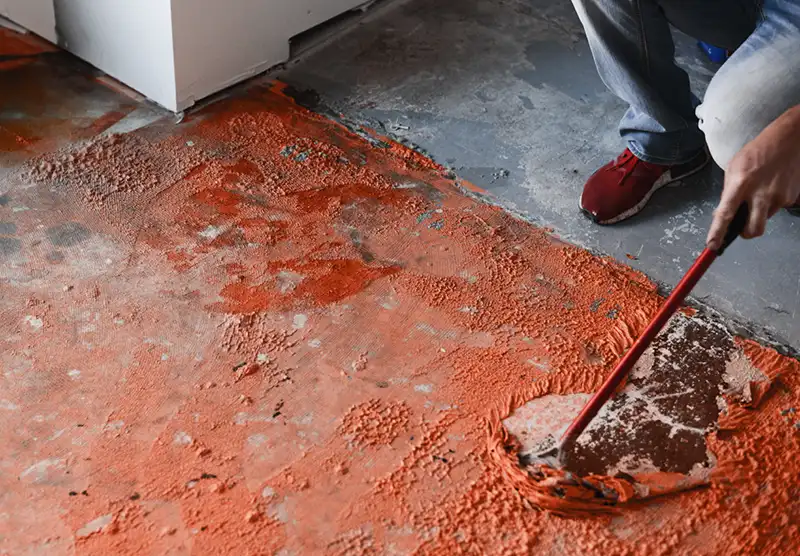Whether at home or on an industrial scale, painting concrete surfaces is a great way to freshen and protect a space. But before you begin a concrete painting project, necessary preparation is the foundation for a beautiful, lasting result. I’ll cover practical topics, from necessary pre-painting preparations like surface cleaning and crack repair to the actual application of concrete paint. I’ll also cover cost considerations and how to remove unwanted spray paint from concrete. I hope to help all of you readers make your concrete surfaces look their best.
What preparations are needed before cement painting?
People are getting excited about applying cement paint to concrete, but the process isn’t as simple as picking up a brush and paint and getting started. Proper preparation can help you achieve a long-lasting and professional finish. Follow me as I look at some of the preparations and pretreatments you must do before you get started.
Protect yourself and your workplace
Before you even think about opening up your cement paint and getting started, let’s take a look at the safety issues of painting. Cement paint may seem like a simple task, but it involves handling chemicals and tools, and some basic protective measures are required.
- Wear protective gear: Start by putting on goggles, gloves, and a dust mask. Cement paint can release harmful particles and fumes that irritate your eyes, skin, and lungs. If you’re using an electric sander, it’s also a good idea to wear earmuffs.
- Ensure good ventilation: If you’re working indoors, open doors and windows to ensure adequate air circulation. Use fans if necessary to keep air circulating and reduce the accumulation of bad gases.
- Protect your surroundings: Cover nearby surfaces with dust sheets or plastic sheets to prevent accidental spills and splashes. Cement paint is difficult to remove once it sets.
Gather your tools and materials
Making a complete tool list and having the right tools and materials ready can save you a lot of time and frustration. Here are the essential tools you must have ready before you begin:
- Cleaning supplies: A broom, a stiff-bristle brush, a vacuum cleaner, and a pressure washer (if available) to thoroughly clean the concrete surface.
- Surface preparation tools: A scraper, wire brush, or grinder to remove old paint and rough spots. For larger areas, consider renting a floor sander.
- Painting materials: Concrete patch or crack and hole filler. You will need a putty knife or trowel for this.
- Painting tools: High-quality paint rollers and brushes designed for rough surfaces, a paint tray, and painters tape to protect adjacent areas.
- Concrete paint: Choose a paint specifically formulated for concrete surfaces. Make sure you have enough paint for at least two coats.
Begin surface preparation
Proper preparation of the concrete surface is essential to achieve a long-lasting smooth finish. Typical surface preparation involves the following:

Cement paint pretreatment
- Cleaning: Concrete is porous and easily accumulates dirt, oil, and other contaminants. Before painting, the surface must be spotless. First, sweep the area thoroughly to remove loose dirt and debris. Use a stiff-bristle brush to brush away any embedded dirt. If conditions permit, you can equip a pressure washer, use it to deep clean the surface. This will help remove stubborn dirt, oil, and any old, loose paint.
- Remove old paint: If your concrete surface has been painted before, you will need to remove any old paint that has peeled or flaked. It is usually recommended to use a paint scraper or wire brush to remove loose or flaking paint. For larger areas, an electric sander or grinder can make the job easier and faster. Be sure to sand down the edges of any remaining paint to create a smooth base.
- Repair imperfections: Due to the material properties of concrete, we often find cracks, holes, and other imperfections on its surface that need to be addressed before painting. Use concrete patching compound to fill any cracks or holes. Apply the patching compound with a putty knife or trowel, smoothing it out to create an even surface. Once filled, follow the patching compound’s instructions and allow it to dry and cure thoroughly. Once the patching compound is dry, sand the patched area to ensure a smooth, even surface. Please note that any dust created by sanding will need to be cleaned up before moving on to the next step.
Before you begin painting, take a moment to inspect your work. Make sure the surface is clean, flat, and free of any dust or debris. Any imperfections at this stage will be magnified after painting, so it’s worth taking the time to get them right. It’s also important to check the humidity of the concrete surface. Too much humidity can easily cause paint to fall off after application, so be sure to wait until the concrete is completely dry before proceeding. Once the surface is properly prepared, you can begin painting.
Proper preparation is the key to a successful cement painting project. By following the above steps, you will ensure that you get a higher quality painting result.
How do you apply cement paint?
Once you have prepared your concrete surface by cleaning and pre-treating it, you can begin applying cement paint. This process involves multiple steps and a lot of time to ensure that the final coating is long-lasting. From priming to applying the final coat, each stage is critical.

How do you apply cement paint
1. Apply the first coat of primer
The first coat applied is often called a primer or base coat. It serves as the first coat to cover the concrete and provide a better bond for subsequent coats to adhere to the concrete surface. Choose a polymer-type primer designed for concrete surfaces. A good primer can help seal porous concrete, prevent moisture from penetrating, and create a smooth surface for cement paint to adhere to. Use a thick-nap roller or brush (when painting smaller, more detailed concrete objects) to apply the primer in an even and consistent back-and-forth motion, ensuring that the surface is completely covered.
After the first coat is applied, let it dry naturally for 24 to 48 hours for the primer to dry completely. The specific time depends on the paint formula and weather conditions. Good drying is essential to prevent the paint from flaking or bubbling.
2. Apply the second coat of cement paint
Once the primer is dry, it is time to apply the second coat of cement paint. This layer of cement paint will begin to give the surface its final color and texture. As with the first coat of primer, choose a high-quality cement paint that is suitable for the type of surface you are working on, whether it is an interior floor or exterior wall. Make sure to choose a product that is resistant to moisture, UV rays, and abrasion.
At this step, you can add your desired pigments and additives to the paint to help achieve the color and effect we have in mind. Mixing different liquids may cause precipitation, so stir thoroughly before use to ensure that all ingredients are evenly mixed. Then, as with the primer, begin to apply it evenly back and forth on the concrete surface.
Once applied, give it enough time to dry. Check the paint supplier’s instructions for specific drying times, as rushing this step may affect the durability of the paint.
3. Final topcoat
The final coat is to make the appearance more beautiful and smooth and ensure long-term durability. This layer should be applied carefully because it is a visible surface that will be subject to daily wear and tear. Before applying the final coat, check the surface for any imperfections, such as bumps or drips that were accidentally left when applying the previous coat. Lightly sand any imperfections to create a smooth surface for the final coat.
Then apply the final coat in the same manner as before, with a more even roller or brush recommended. Be careful not to overload them, as too much liquid can cause dripping and an uneven surface. Keep the pressure on the roller consistent during the application process and avoid leaving visible seams or lines between areas.
After you finish painting, allow 48 hours or more for the paint to cure completely, depending on the product and environmental conditions. Avoid heavy foot traffic or placing items on the surface before the paint is fully cured to prevent unwanted stains on the cement paint. Applying cement paint may seem simple, but details at every stage, from primer to final coat, are important. Sometimes a small oversight may lead to problems with the final effect. You can check out some common problems in applying cement paint in our corresponding blog. With the right preparation, tools, and techniques, you can get a professional, durable finish that enhances the appearance and functionality of your concrete surface. Based on my past experience, I have summarized the top ten tips for applying cement paint, and I hope it will be helpful to you.
- Plan Your Work in Sections: Especially for large surfaces, work in sections to maintain a wet edge and avoid visible overlaps or streaks.
- Check Weather Conditions: For exterior projects, avoid painting in extreme temperatures or high humidity, which can affect drying and adhesion.
- Use Quality Tools: Invest in high-quality brushes and rollers designed for rough surfaces. Cheap tools can shed bristles or foam, ruining your finish.
- Stir Regularly: Cement paint can settle quickly, so stir it often during application to keep the consistency even.
- Don’t Skimp on Drying Time: Allow each coat to dry completely before adding the next. Skipping this step can lead to peeling or bubbling.
- Thin Coats Are Better: Apply multiple thin coats rather than one thick coat. This reduces the risk of drips and ensures a smooth, even finish.
- Watch for Drips: Check for drips or runs as you go, especially around edges and corners. Use a brush to smooth them out immediately.
- Seal After Painting: For added protection, especially in high-traffic or outdoor areas, consider applying a concrete sealer over the dried paint.
- Use a Masking Tape: Protect areas you don’t want to paint with high-quality painter’s tape. Remove the tape while the paint is still tacky to avoid pulling up dried paint.
- Keep a Clean Workspace: Clean your tools immediately after use, and keep the workspace free of dust and debris to prevent them from sticking to the wet paint.
How much does it cost to paint a concrete cement surface?
Now that you know the techniques and tips for applying concrete paint, you need to consider how much it will cost to paint your concrete cement surface. Before you begin your project, understanding the factors that affect the overall cost can help you plan your budget more effectively. Factors such as the surface area of the concrete, the type of paint used, the surface condition, the labor, and the tools involved will all directly affect the final cost of your concrete painting project.
- Concrete surface area: The larger the area that needs to be painted, the more paint, tools, and time you will need, which will naturally increase the cost. Measure the square footage of the surface before you begin to get a rough estimate.
- Type of paint: Not all concrete paints are the same. Depending on the requirements of your project, you can choose between acrylic, epoxy, or polyurethane paints. Each polymer coating varies in price, durability, and application characteristics.
- Surface condition: If your concrete surface is damaged or already painted, you may need additional materials and labor for repair and surface preparation. This may include filling cracks, sanding, and applying primer, which will all increase the total cost.
- Labor costs: If you plan to do it yourself, this part can be ignored and only requires time. If you hire a professional, labor costs will account for a large part of your budget. Costs can vary greatly depending on location and project complexity.
- Application method: Depending on the type of concrete surface, we will choose between spraying and brushing. Usually, when it is not convenient to paint with brushes, such as statues or exterior walls, you need to buy or rent spraying equipment.
- Other tools and materials: In addition to paint, you may also need tools such as rollers, brushes, sprayers, primers and sealants. These materials and tools are inconspicuous, but they will be a considerable expense after purchasing them in full.
- Number of paint coats: Applying multiple coats of paint ensures a more durable and vivid effect, but it also means using more paint and extending the project time.
| Example of General Concrete Coating Costs | ||
|---|---|---|
| Application | Paint Type | Average Cost per Square Foot |
| Outdoor Driveway/Patio | Acrylic Concrete Paint | $2.50 – $5.00 |
| Epoxy Concrete Paint | $3.00 – $6.00 | |
| Polyurethane Concrete Paint | $3.00 – $7.00 | |
| Concrete Stain | $2.00 – $4.00 | |
| Garage Floor | Epoxy Garage Floor Paint | $3.00 – $8.00 |
| Polyurethane Floor Paint | $4.00 – $10.00 | |
| Acrylic Floor Paint | $3.00 – $7.00 | |
| High-Performance Epoxy Coating | $6.50 – $14.00 | |
| Basement Floor | Polyurethane Floor Paint | $5.00 – $10.00 |
| Epoxy Floor Paint | $4.00 – $8.00 | |
| Acrylic Floor Paint | $3.00 – $6.00 | |
| Moisture Barrier Coating | $6.00 – $10.00 | |
| Decorative Concrete Walls | Concrete Stain or Sealer | $3.00 – $5.00 |
| Acrylic Wall Paint | $3.00 – $8.00 | |
| Epoxy Wall Coating | $4.00 – $8.00 | |
| Limewash or Mineral Paint | $3.00 – $8.00 | |
| Commercial Spaces | High-Performance Epoxy | $6.00 – $14.00 |
| Polyurethane Coating | $5.00 – $12.00 | |
| Acrylic Coating | $4.00 – $9.00 | |
| Elastomeric Coating | $5.00 – $12.00 | |
Painting concrete cement surfaces is a cost-effective way to enhance the look and longevity of a space. Using the general price list and necessary factors to consider listed above, you can make a rough estimate based on local market prices.
How to get spray paint off cement?
Due to painting mistakes, too much paint or unwanted patterns are applied. Or the previously applied cement paint has aged and lost its beauty. In these cases, we want to remove the unwanted paint. With the right basic cleaning tools and the right cleaning methods, you can restore the concrete surface to its former glory.
Before you start, please prepare some necessary tools in advance, such as: protective gear (gloves, goggles, masks, etc.), paint remover, pressure washer, wire brush, soapy water, etc. If the paint is freshly applied, soap and water can easily solve the problem. You can also mix warm water and a small amount of paint remover to make a solution. Use a stiff-bristled brush to scrub the affected area in a circular motion. If the paint is already dry, more drastic measures are required for cleaning.

Solvent removal of cement paint
- Apply a large amount of paint stripper or remover to the area to be cleaned and let it sit for a few minutes according to the instructions to help soften the paint (usually 15-30 minutes is enough).
- Then apply some pressure and use a wire brush or scraper to scrub off the softened paint.
- After scrubbing, rinse the area with water. If conditions permit, using a pressure washer can effectively remove paint from porous surfaces such as cement. Repeat this process 2-3 times.
- If you encounter stubborn paint, traces of the paint may still remain. This is when TSP (trisodium phosphate) is recommended. Follow the instructions to mix TSP with water to make a strong solution. Follow the steps again and you can restore the concrete surface to its original state. One note: After using TSP, be sure to rinse the area thoroughly with water to remove any residue, as TSP is a strong chemical that will affect the subsequent repainting effect.
For small patches of unwanted paint, taking quick action can make a big difference. The sooner you address these blemishes, the easier it will be to remove. Removing spray paint from cement can be a bit difficult, but with the right tools and techniques, you can restore the surface to its original state. Whether it is a small area or a large area, these steps should help you complete the job effectively.
I’ve walked you through the entire process of concrete painting, from basic preparation steps to practical application tips and cost breakdowns. Whether you’re looking to improve your home or commercial space, knowing these basics will set you up for success. For more resources, tools, and connections to the top suppliers and experts in the coatings industry, visit coatingsdirectory.com. Our comprehensive business directory is designed to help you find the perfect concrete coating and local painting services for any project. Happy painting!
How long does cement paint take to dry?
Cement paint usually takes about 48-72 hours to dry to the touch, but it can take up to 7 days to fully cure, depending on the weather conditions and thickness of the application. It’s best to wait at least a day before walking on the surface and a full week before placing heavy objects. This ensures the paint bonds properly to the concrete and achieves maximum durability. Remember, temperature and humidity play a big role—cooler, more humid conditions can slow down drying time.
Can you epoxy a painted concrete floor?
Yes, you can apply epoxy over painted concrete, but there’s a catch! The existing paint must be in good condition, meaning it should be fully adhered to the surface without any peeling or flaking. It’s also crucial to sand the painted surface lightly to create a rough texture for the epoxy to grip onto. After that, clean the surface thoroughly to remove dust and debris. If the old paint is not stable, it’s better to strip it off first to avoid adhesion issues.
Can I paint over existing paint on concrete?
Absolutely! You can paint over existing paint on concrete, but only if the old paint is well-bonded and not peeling or cracking. Clean the surface thoroughly to remove any dirt, grease, or mildew, and lightly sand it to improve adhesion for the new coat. If the existing paint shows signs of wear, it’s better to remove it before applying fresh paint. This way, you ensure a smooth, durable finish that won’t flake off easily.
Does it always need to prime concrete before painting?
Not always, but it’s highly recommended! Priming concrete before painting helps the paint adhere better and last longer, especially if the surface is porous or has never been painted before. A good primer will also seal any small cracks and imperfections, giving you a smoother, more uniform finish. However, for pre-painted or sealed concrete, priming might not be necessary if the existing surface is in good condition.

